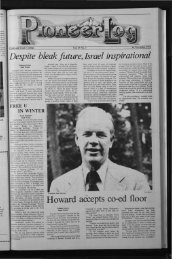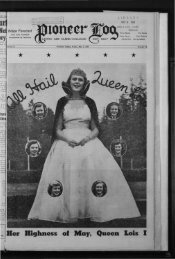Footprints of Pacifism - Lewis & Clark Digital Collections - Lewis ...
Footprints of Pacifism - Lewis & Clark Digital Collections - Lewis ...
Footprints of Pacifism - Lewis & Clark Digital Collections - Lewis ...
Create successful ePaper yourself
Turn your PDF publications into a flip-book with our unique Google optimized e-Paper software.
Kermit Sheets in Theater and Film — Case Four<br />
The programs and advertisements shown here are samples<br />
<strong>of</strong> the busy postwar life <strong>of</strong> Kermit Sheets in San Francisco<br />
theater and film: A mailer for the plays Aria Da Capo (Edna<br />
St. Vincent Millay), Don Perlimpin (Lorca) and Heartbreak House<br />
(Shaw) playing in repertory in August and September 1947,<br />
the three earliest Interplayers productions. Three programs<br />
with Sheets as director, designer, or actor: Sartre’s No Exit<br />
(July/August 1948); Broughton’s Fête Gala <strong>of</strong> poetry, theater<br />
and film; Fanny’s First Play by Shaw (August/November<br />
1951, the last production before the Interplayers split into<br />
two companies and Broughton and Sheets left for Europe.All<br />
these items were designed by Interplayers co-founder Adrian<br />
Wilson, later one <strong>of</strong> America’s finest printers.<br />
Also exhibited: titles and stills from two films, the second and<br />
fourth <strong>of</strong> Broughton and Sheets’s Farallone Productions, both<br />
starring Kermit Sheets: Loony Tom the Happy Lover (California<br />
1951), and The Pleasure Garden (London 1953), winner <strong>of</strong> a<br />
Cannes Festival award for poetic fantasy.<br />
After his return from Europe, Sheets became managing director<br />
<strong>of</strong> The Playhouse until the early 1960s, mounting many<br />
successful productions, including Helen Adam’s long-running<br />
San Francisco’s Burning (December 1961–June 1962) with music by Warner Jepson. In 1965 he married Jane Steckle,<br />
who died in 1999. From 1970 to 1980 he was director <strong>of</strong> the Center at the Lighthouse for the Blind.<br />
After retirement he spent much <strong>of</strong> his time writing and traveling with Jane. He died on April 6, 2006 in San Francisco.<br />
Kemper Nomland’s Work After the War — Case Five<br />
After the war Kemper Nomland returned to southern California where he and William Eshelman continued to issue<br />
volumes <strong>of</strong> The Illiterati and publish works <strong>of</strong> poetry with the Untide Press imprint. Kemper also resumed his career<br />
as an architect. Initially, he worked with his father Kemper Nomland, Sr. Among the Nomlands’ projects was the<br />
design for Case Study House #10. The Case Study House project was an idea created by the founder <strong>of</strong> the Arts &<br />
Architecture magazine who wanted to create modern homes for the booming post war housing market in California.<br />
The Nomlands’ design for Case Study House #10 exhibited Kemper’s focus on simplicity and functionality.<br />
After his marriage to Ella Kube, who taught psychology at <strong>Lewis</strong> & <strong>Clark</strong> College (1950-51), Nomland continued<br />
to be a sought after Southern California architect. Notable among the homes and public buildings he designed was<br />
a redesign <strong>of</strong> Moore Hall at UCLA. Nomland also continued to experiment with drawing, painting, and ceramics.<br />
6





